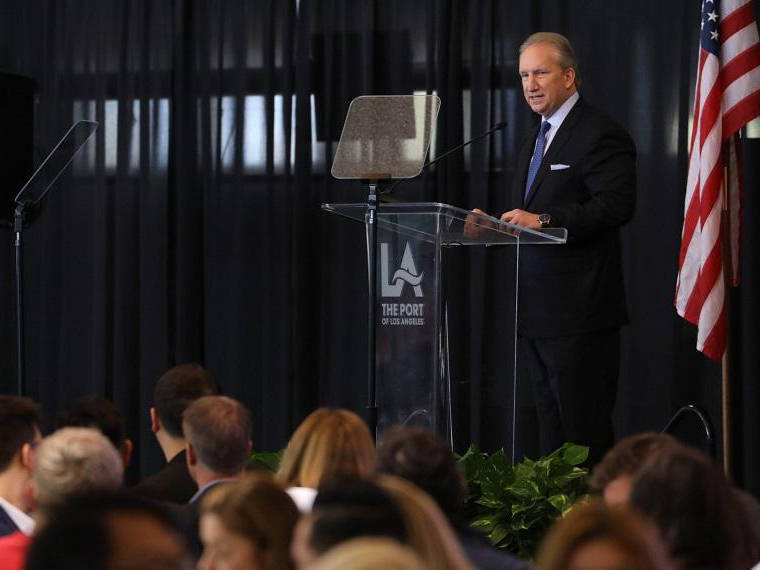2019 cargo volumes at Port Of Los Angeles at near-record levels
Jan 17, 2020Port Executive Director announces initiatives for terminal efficiency, digital leadership, workforce development
San Pedro, CA– The Port of Los Angeles moved near-record cargo in 2019 with a total of 9,337,632 Twenty-Foot Equivalent Units (TEUs), just short of the second-best year in its 113-year history. The milestone was announced by Port Executive Director Gene Seroka at the annual State of the Port event hosted by the Pacific Merchant Shipping Association.
“In the face of lagging exports due to international trade tensions and tariff uncertainties, the Port of Los Angeles has maintained strong momentum and kept cargo flowing,” Seroka said. “This feat was only possible because of the extensive cooperation and continued efficiency improvements by our terminal operators, supply chain partners and longshore workforce.”

Seroka outlined a number of Port initiatives that will take shape in 2020 and beyond.
“It’s time for the courage and long-range vision to imagine what this Port will look like in the years ahead and set a course in that direction,” Seroka said. “It’s going to take collaboration to keep cargo volumes strong and our Port community thriving in the midst of increasing competition, an uncertain trade environment and a world where technology is essential to success.”
Seroka announced the planned launch of the nation’s first Terminal Efficiency Incentive Program. In conjunction with a new Port of Los Angeles truck reservation system also planned for this year, the efficiency initiative would tie improvements in truck turn times to a Port incentive reward program.
“Depending on the percentage a terminal can reduce truck turn times, they will be monetarily rewarded on each container unit. The higher the percentage of reduction, the bigger the reward,” Seroka said. The program is expected to improve drayage efficiency and further reduce truck turn times.
In 2020 the Port will continue to explore locations for off-dock chassis yards. Yusen Terminals has developed a near dock chassis staging area, and the Port is currently in negotiations with Pacific Crane Maintenance Company to develop an off-dock chassis facility that complements APM Terminal’s Pier 400 operation. These efforts will help relieve terminal congestion and improve overall chassis use port-wide.
Seroka also announced the launch of the Port of Los Angeles Labor Collaborative, a new Port-driven workforce development initiative focused on identifying specific employment and training needs within the Port ecosystem. Separately, an initiative will kick off next week with distribution of a Port stakeholder survey to assess current and future training and technical needs.
Technology infrastructure also was a key theme of Seroka’s remarks as the Port works to accelerate digital transformation of the supply chain by creating a port community system to connect critical cargo data points. The Port continues to be recognized as one of the nation’s leading digital “Smart Ports” with its Port Optimizer™ online information portal continuing to gain ground. The system covers 95% of all the containerized cargo flowing through the Port. Nine of the 10 leading carriers are feeding data into the Port Optimizer, and Wabtec, the Port’s digital partner in development of the Port Optimizer is now exploring end-to-end supply chain data integration with leading blockchain providers.
In the coming week, pending approval by the Los Angeles Board of Harbor Commissioners, the Port anticipates announcing the selection of its partner for the design and construction of a new Cyber Resilience Center. The Center will serve as a neighborhood “cyber-watch” system to protect data flowing through the port community.
Seroka reiterated 2020 as an important year for ongoing implementation of the Clean Air Action Plan, as well as the Port’s continued pursuit of zero-emission technology to further build on emission reductions achieved over the last decade. Currently the Port is testing 78 zero-emission drayage trucks and 74 zero-emission yard tractors, and working with Port partners to test eight new zero-emission top handlers in the coming year. On tap for 2020 will be additional demonstration projects, including a new large-scale zero-emission drayage truck project testing a fleet of 50-100 zero-emission trucks.
Similar Stories

NOBLELIFT North America welcomes Pedriana as new president
View Article
Orange EV announces new additions to the leadership team
View Article
Mukran Port starts the year 2025 with new management
View Article
Crowley acquires Main Line Inc., expanding harbor services with mooring capabilities
View Article
Roberts to lead Savage as international supply chain company’s 4th CEO in nearly 80-year history
View Article
Valenciaport implements its own 5G connection network
View ArticleGet the most up-to-date trending news!
SubscribeIndustry updates and weekly newsletter direct to your inbox!





